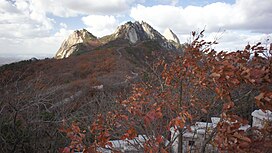Bukhansan
| Bukhansan | |
|---|---|
 The three peaks of Bukhansan
Location | |
| Highest point | |
| Elevation | 836.5 m (2,744 ft)[1] |
| Coordinates | 37°39′39″N 126°59′36″E / 37.6608°N 126.9933°E |
| Geography | |
 | |
| Location | South Korea |
| Climbing | |
| Easiest route | from Bukhansan Ui Station(북한산우이) then walk 2.29km to Bukansan National Park Visitor Center(북한산국립공원백운탐방지원센터) |
| Korean name | |
| Hangul | |
|---|---|
| Hanja | |
| Revised Romanization | Bukhansan |
| McCune–Reischauer | Puk'ansan |
Bukhansan (Korean: 북한산, lit. 'North Han Mountain'), or Bukhan Mountain, is a mountain on the northern periphery of Seoul, South Korea. There are three major peaks, Baegundae 836.5 meters (2,744 ft), Insubong 810.5 meters (2,659 ft), Mangyeongdae 787.0 meters (2,582.0 ft).[1] Because of its height and the fact that it borders a considerable portion of the city, Bukhansan is a major landmark visible from most city districts. The name "Bukhansan" means "mountain north of Han River", referring to the fact that it is the northern border of the city.[2] During the Joseon era, the peaks marked the extreme northern boundary of Seoul.
Bukhansan is the highest mountain within Seoul city boundaries. Apart from Bukhansan, there are seven other mountains including Dobongsan and Suraksan that are over 600 meters high within the city.[3]
Popular throughout the year, Bukhansan, and Bukhansan National Park, which was formed in 1983,[4] are renowned for birdwatching, hiking and rockclimbing. Bukhansan attracts a large number of hikers; around 5 million per year.
Name
Since 2002 there has been a movement to revert the name of Bukhansan to Samgaksan. For many years up until now, the three main peaks of the park have collectively been called "Bukhansan"; however, the original collective name of these three peaks was Samgaksan, meaning "three-horned mountain." The head of the Gangbuk-gu District Office in Seoul is leading a petition to have the central government change the name back to the original.[5]
Hiking
There are numerous hiking courses accessible to the average hiker within Bukhansan National Park. The trails are open year-round but may be closed during fire season in the Spring and Autumn at the discretion of the park director.
| Name | Points of Interest |
|---|---|
| Bukhansanseong Fortress Course | Bukhansanseong Hiking Support Center (북한산성탐방지원센터) → Daeseomun (대서문) → Deungungak (등운각) → Baegundae (백운대) |
| Sinseondae Course | Dobong Hiking Support Center (도봉탐방지원센터) → Seowonteo (서원터) → Dobong Shelter (도봉대피소) → Seokguram (석굴암) → Sinseondae (신선대) |
| Mangwolsa Temple, Podae and Hoeryong Course | Wondobong Hiking Support Center (원도봉탐방지원센터) → Deokjesaem (덕제샘) → Mangwolsa Temple (망월사) → Podae Ridge (포대능선) → Hoeryong 4-way Intersection (회룡사거리) → Hoeryong Hiking Support Center (회룡탐방지원센터) |
| Uiam Course | Dobong Hiking Support Center (도봉탐방지원센터) → Bomun Ridge (보문능선) → Cheonjinsa Temple (천진사) → Uiam (우이암) |
| Obong Course | Songchubunso (송추분소) → Songchu Waterfall (송추폭포) → Obong 3-way Intersection (오봉삼거리) → Obong Peak (오봉) → Yeoseongbong Peak (여성봉) → Obong Hiking Support Center (오봉탐방지원센터) |
| Sapaesan Mt. Course | Songchubunso (송추분소) → Hoeryong 4-way Intersection (회룡사거리) → Sapaesan Mt. (사패산) → Wongaksa Temple (원각사) → Entrance of Sapaesan Mt. (사패산입구) |
| Daenammun Course | Bukhansanseong Hiking Support Center (북한산성탐방지원센터) → Daeseomun (대서문) → Jungseongmun (중성문) → Daenammun (대남문) |
| Samobawi Rock Course | Gugi Hiking Support Center (구기탐방지원센터) → Daenammun (대남문) → Cheongsudongammun (청수동암문) → Samobawi Rock (사모바위) |
Gallery
This section contains an unencyclopedic or excessive gallery of images. |
-
A shrine in Bukhansan
Films and literature
Daum webtoon manwha PEAK by author Hong Sun-soo and artist Im Gak-hyuck is a fictional work based on the mountain rescue team working in this mountain.[7]
References
- ^ "Bukhansan National Park (Dobong) (북한산국립공원(도봉 지구))". KOREA TOURISM ORGANIZATION. Retrieved 27 February 2015.
- ^ "Best Hiking Mountains in Seoul". Visit Korea. Retrieved 17 November 2012.
- ^ "Introduction to Bukhansan". Korea National Park Service. Retrieved 27 February 2015.
- ^ Park, Jin-woo (박진우) (2007-06-14). "북한산, 본래 이름 '삼각산' 되찾아야". Sports Hankook. Retrieved 2007-06-21.
- ^ "Bukhansan National Park (Dobong) (북한산국립공원(도봉 지구))". Korea Tourism Organization. Retrieved 27 February 2015.
- ^ http://webtoon.daum.net/webtoon/view/peak
External links
- Best Hiking Mountains in Seoul by Visit Korea, 2012
- Bukhansan National Park (북한산국립공원) by Visit Korea, 2012
- Bukhansan Hiking Club, 2014










